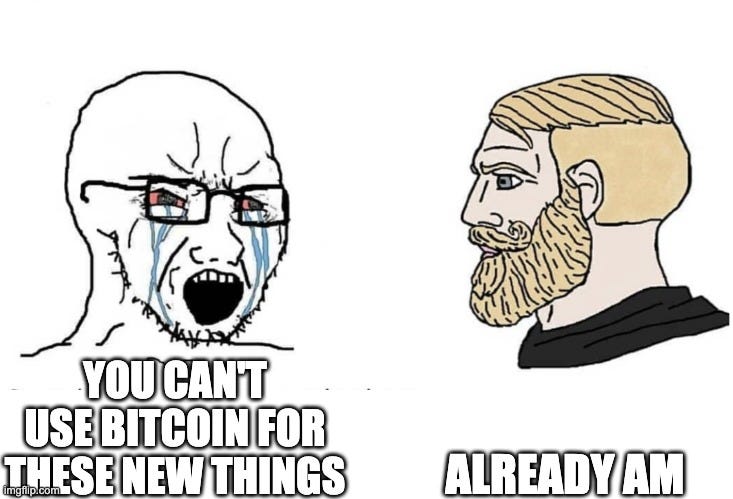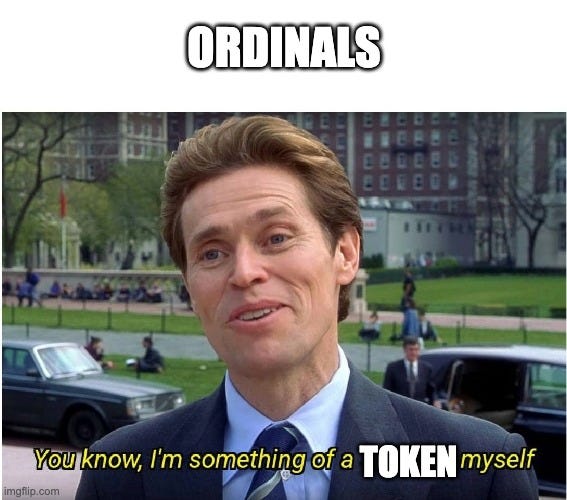Ordinals are a new way to own assets through the Bitcoin blockchain. While this isn’t the first time assets have been built on top of Bitcoin, Ordinals are a different beast to what’s come before. They take units of BTC and assign each a number, allowing any unit of BTC to represent ownership of an additional asset. No protocol changes were made, but Ordinals have transformed Bitcoin. Let’s dive in.
Sections
What are Ordinals?
How do Inscriptions Work?
What can Ordinals be Used For?
What are the Ordinal Token Standards?
Closing Thoughts
My Other Writings! - New Section!
Ordinals
Ordinals are basically a numbering system for satoshis, also known as sats. Each sat is a small unit of BTC, (1/100,000,000 of one BTC, to be precise), and the Ordinal system has assigned individual numbers to each. The numbers start from 1 through 100,000,000 for all the sats in the very first Bitcoin, and continue after that for all the other Bitcoin that’s been mined to date.
The system keeps track of sats when they move out of a wallet, so it’s always known where each specific sat is.
So each sat has an individual number, but how does that allow them to represent assets on Bitcoin?
Inscriptions
Under the Ordinal system, each sat can be assigned a piece of data through a process called “inscription.” Sats are just currency, they don’t have a space to hold data. Instead, Ordinals creates a system to connect those sats with pieces of data.
When someone inscribes something, they send a transaction with the sat the inscription will happen to, and add the data they’d like to see there. When this happens, the Ordinal system will associate the new data with that individual sat. The satoshi and the inscribed data become connected.
Under the hood, the data is actually stored in a separate part of Bitcoin blocks called the “witness” section. This section holds the signatures that prove transactions in a block are valid, but it can also hold extra data too. That space for extra data is where inscribed data actually exists.
Any data inscribed becomes a part of the Bitcoin blockchain itself. The way that data connects to a specific sat is through the Ordinal system; it allows data inscribed “on to” sats in this way to be displayed.
Applying Ordinals
With Ordinals came a way to track sats and associate data with them. This was used to effectively make NFTs, where each inscribed sat was distinct from any other. They were, however, too distinct; since each ordinal is it’s own thing, they could not be used to create collections.
A few more steps were necessary to bring them closer to the tokens we’re all familiar with. Such steps have been taken, and the token standards they’ve resulted in have very familiar names.
Types of Ordinal Tokens
BRC-721
The Ordinal standard for NFTs aimed to figure out how to create an association between a group of inscriptions. While on Ethereum this is all managed by a smart contract, no such luxury exists on Bitcoin. The association between inscriptions has to be created separately.
BRC-721 works by first inscribing a sat with the details about the “collection” you’re creating. It’ll specify the maximum limit of tokens in the collection, the collection’s title, and other general things like that. The data specified in this “Collection Manifest” applies to all the inscriptions in the collection (i.e. if someone tries to inscribe a sat into the collection but its past its limit, it won’t be included in the collection at all).
Next, another sat is inscribed with the metadata for the collection. Just like how the images for Ethereum NFTs are held off-chain, so too is the art for BRC-721 collections. The art is held elsewhere, and connected to the collection using this second sat, called the “Reveal Manifest.”
One final sat is set up as the “Inscription Manifest,” which details the price to inscribe ordinals to the collection.
When someone mints a BRC-721 NFT, they inscribe a sat with the same information as is in the Manifests, and pays the fee to the creator of the collection to be able to do so. If they don’t pay the fee, then their claim will be considered invalid and their inscription won’t become a part of the collection.
The sat the NFT is inscribed onto represents ownership of the token. To transfer the NFT to someone else, you need to send that specific sat. Ordinal-ready wallets have been created to make this easier.
Boom! Bitcoin NFTs!
BRC-20
BRC-20 tokens are intended to be fungible (i.e. exchangeable for any other unit of its type), but the way they’re created is pretty similar to the Ordinal NFTs discussed above. Instead of 3 different manifests, though, just a single one is used to specify the properties of a token collection.
Things are a little more interesting when someone mints some BRC-20 tokens. When that happens, all the BRC-20 tokens they mint are inscribed onto a single sat. The alternative would be one sat per token, which would be much more expensive.
Let’s say you want to send your BRC-20 tokens to someone else. If you sent them the single sat that they’re all inscribed upon, they’d have all of the tokens! How could you only send them some of them instead? By inscribing the amount you want to send onto a new sat.
Regardless of how many tokens are inscribed onto a specific sat, that amount can be split and inscribed onto two sats instead. This is why sales of BRC-20 tokens happens in set chunks: the amount being sold is all that’s inscribed onto a specific sat that’s for sale.
Closing Thoughts
Ordinals are pretty cool. They use the basic pieces of an intentionally basic blockchain to make new possibilities happen. The framework allows for independent NFTs that are fully on the Bitcoin blockchain, standard collections like we’ve come to expect on Ethereum, and now fungible tokens too! More tools and adoption are likely to come, a breath of fresh air on Bitcoin!
My Other Writings!
I’ve been writing a lot lately, and wanted to share my other pieces with you all!
Here you’ll find the other articles I’ve written since my last write-up.
Thank you for supporting me and making this possible. Yes, you.
How the Lightning Network is supercharging Bitcoin - w/ Cryptonary
Record week for ETH staking – all you need to know - w/ Cryptonary
Thank You & Additional Reading!
Thanks a lot for reading! Here are some more resources if you'd like to dive deeper.
Subscribe below if you haven’t for more simple write-ups on blockchain concepts!
If you’ve signed up, thank you! Consider sharing this write-up with others below.






